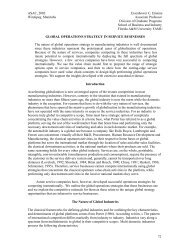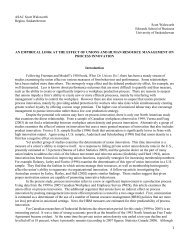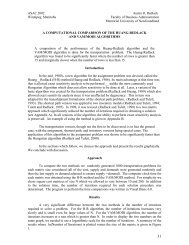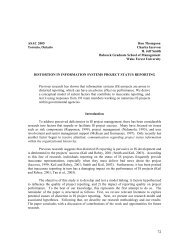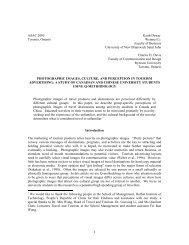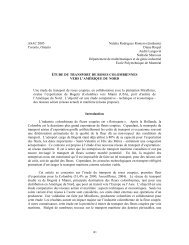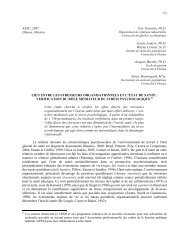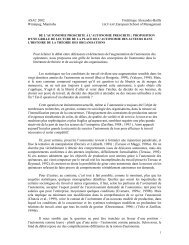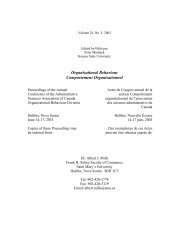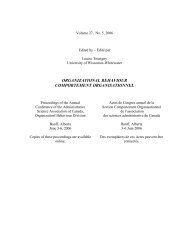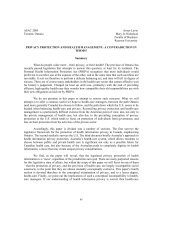ASAC-IFSAM 2000 Conference
ASAC-IFSAM 2000 Conference
ASAC-IFSAM 2000 Conference
Create successful ePaper yourself
Turn your PDF publications into a flip-book with our unique Google optimized e-Paper software.
characteristics and qualities be appropriated or exploited for competitive advantage in organizationsthat are still essentially patriarchal (Calas & Smircich, 1993). Furthermore, we do not wish to implythat the consultants and change agents in the two case organizations deliberately wanted tointroduce feminine characteristics. Instead we propose the recent change trends are a response orreaction to a set of characteristics that are no longer appropriate or working in a changingorganizational world. Acknowledging and naming the resistance to the feminization that is takingplace in organizations, allows managers, practitioners and academics to better understand whymasculinist cultures continue to dominate and prevail.Smircich (1985:67) called for the addition of a feminist voice to the cultural research. Wesuggest that the gender analysis of change initiatives offered here goes some way to fulfilling thisaim. We concur with Martin (1990: 357) that “if feminist perspectives were fully incorporated[within organizational analysis], the usual emphases on rationality, hierarchy, competition,efficiency, and productivity would be exposed as only a very small piece of the organizationalpuzzle.” In this paper we have offered an alternative explanation for understanding cultures andchange initiatives based on a gendered analysis of the dominant culture at both Technica andComCo and the underlying characteristics of the change initiatives.We have suggested that an implicit reason for the resistance and ultimately failure of thechange initiatives in the two case organizations were due to the gendered nature of the attemptedchanges. Specifically the underlying and unnamed feminization of the changes and the lack ofawareness of the lesser valued ascribed to the feminine caused the changes not to take hold inpredominantly masculine organizational cultures. Like other writers, we believe that raising theawareness of this feminization/gendered process assists us in understanding organizations asgendered entities. As demonstrated in this paper, such an analysis offers theoretical and practicalinsights into the failure of the change initiatives in the case study organizations – insights thatwould not be gleaned from much of the extant organizational change literature.ReferencesAcker, Joan., Hierarchies, jobs, bodies: A theory of gendered organizations. Gender & Society 4,139-158, 1990.Acker, Joan., Gendering organizational theory. In A. Mills & P. Tancred (eds.) Genderingorganizational analysis, (pp. 248-260). Newbury Park: Sage, 1992.Adler, Nancy. International dimensions of organizational behaviour. (2nd ed). Boston: Kent, 1998..Alvesson, Mats. & Due Billing, Yvonne. Understanding gender and organizations, London: SagePublications, 1997.Alvesson, Mats. & Berg, Per Olof. Corporate culture and symbolism: An overview. Berlin: Walterde Gruyter, 1992.Belbin, Meredith. Team roles at work.. Oxford: Butterworth-Heinemann, 1993.Brown, Andrew. Organizational culture. London: Pitman, 1995.Burrell, Gibson. & Morgan, Gareth. Sociological paradigms and organizational analysis. London:Heinemann, 1979.<strong>ASAC</strong>-<strong>IFSAM</strong> <strong>2000</strong> Proceedings 10



